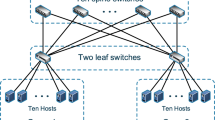Abstract
As technology evolves, it is now feasible to implement sophisticated adaptive routing schemes on networks which support different kinds of services with heterogeneous bandwidth characteristics. Adaptive routing can increase the network throughput by routing calls to less congested paths. It can also be used to bypass transmission facility failures. In this paper, we analyze and compare two adaptive routing schemes. The first is called theMaximum mean time to blocking (MTB) routing which is based on themean time to blocking measure of a link. This measure captures the traffic rates, bandwidth characteristic and link capacity information and reflects more accurately the congestion status of different paths. The second is theM 2 routing, which is a modification of the least loaded routing (LLR). Aggregation of link status information can significantly reduce signalling traffic. We show in this paper that with properly designed aggregation, the aggregatedM 2 and MTB routings can have performance that approach that of the non-aggregated schemes. The use of complete sharing and restricted access policies together with trunk reservation control in multirate loss networks are also studied.
Similar content being viewed by others
References
G.R. Ash et al., Real-time network routing in a dynamic class-of-service network,Proc. Globecom (1992).
S.-P. Chung and K.W. Ross, Reduced load approximations for multirate loss networks, to appear in IEEE Trans. Commun.
W. Wang and N. Saadawi, Trunk congestion control in heterogeneous circuit-switched networks, IEEE Trans. Commun. 40(7)(1992).
S. Gupta, K.W. Ross and M. El Zarki, Routing in virtual path based ATM networks,Proc. Globecom (1992).
Z. Dziong and L. Mason, An analysis of near optimal call admission and routing model for multi-service loss networks,Proc Infocom (1992).
R.-H. Hwang, J.F. Kurose and D. Towsley, State dependent routing for multirate loss networks,Proc. Globecom (1992).
K.-M. Chan, T.-S.P. Yum, The maximum mean time to blocking routing in circuit-switched networks, IEEE J. Select. Areas Commun. 12 (Feb. 1994).
E.W.-M. Wong, T.-S.P. Yum and K.-M. Chan, Analysis of theM andM 2 routings in circuit-switched networks,Proc. Globecom (1992).
R. Guérin, H. Ahmadi and M. Naghshineh, Equivalent capacity and its application to bandwidth allocation in high-speed networks, IEEE J. Select. Areas Commun. 9(7)(1991).
K.W. Ross and D.H.K. Tsang, The stochastic knapsack problem, IEEE Trans. Commun. 37(7)(1989).
D. Mitra, R.J. Gibbens and B.D. Huang, Analysis optimal design of aggregated-least-busy-alternate routing on symmetric loss network with trunk reservations,Proc. ITC-I3 (1991).
M. Schwartz,Telecommunication Network: Protocols, Modeling and Analysis (Addison-Wesley, 1988).
R.A. Howard,Dynamic Probabilistic System, Vol II: Semi-Markov and Decision Processes (Wiley, 1971).
K.E. Atkinson,An Introduction to Numerical Analysis (Wiley, New York, 1978) pp. 450–457.
Author information
Authors and Affiliations
Rights and permissions
About this article
Cite this article
Chan, KM., Yum, TS.P. Analysis of adaptive routing schemes in multirate loss networks. Telecommunication Systems 5, 341–359 (1996). https://doi.org/10.1007/BF02112522
Received:
Revised:
Issue Date:
DOI: https://doi.org/10.1007/BF02112522




